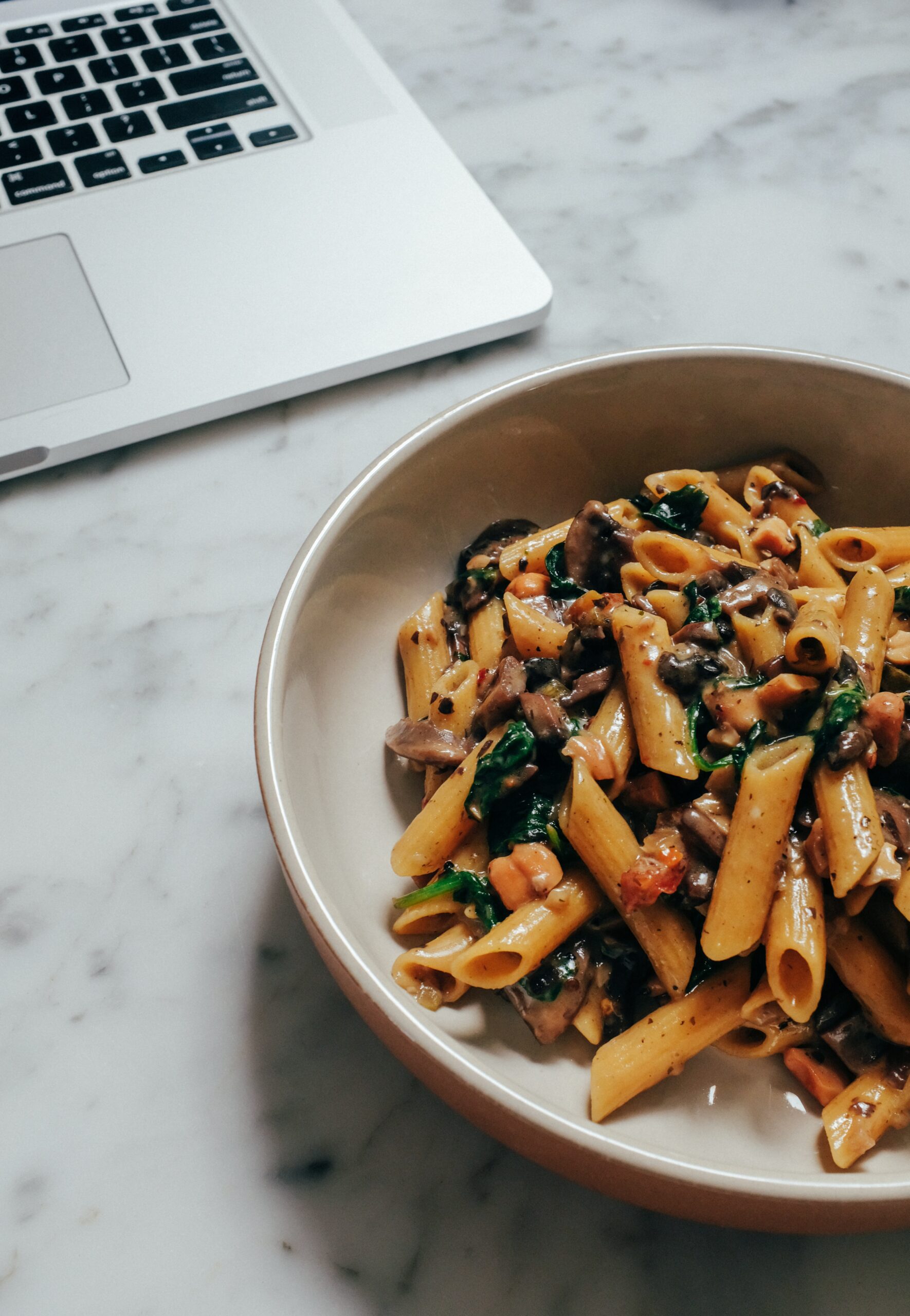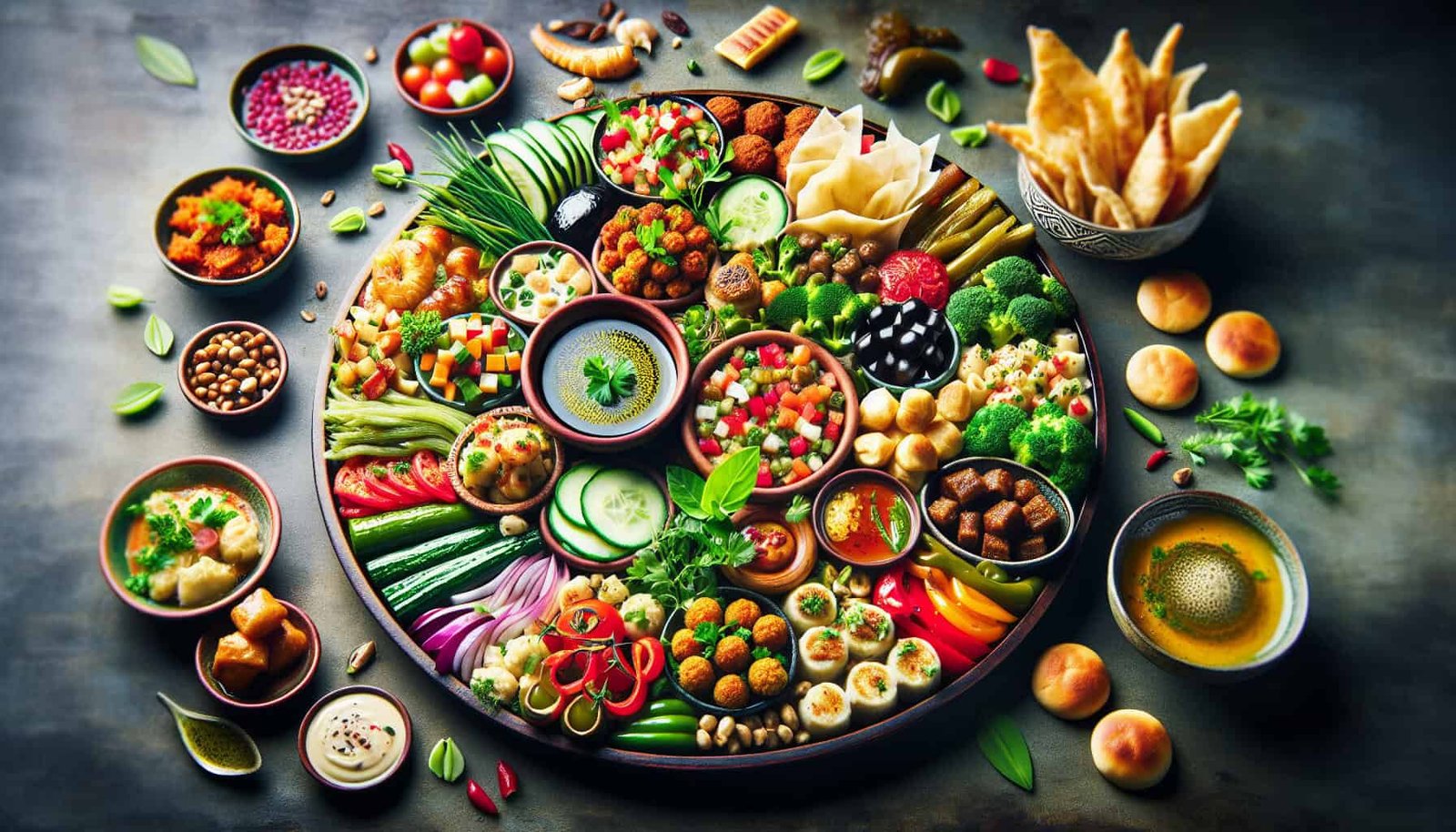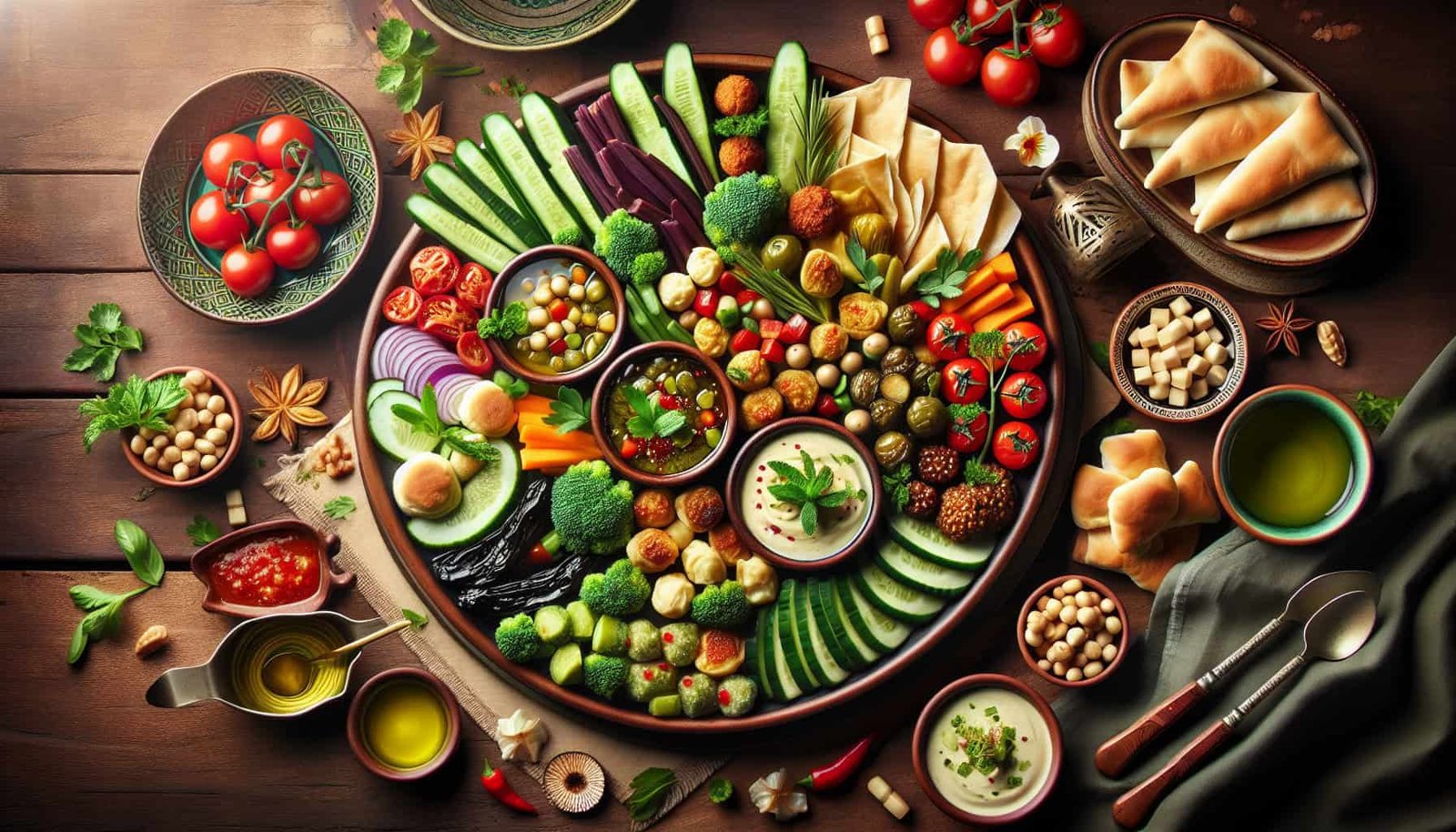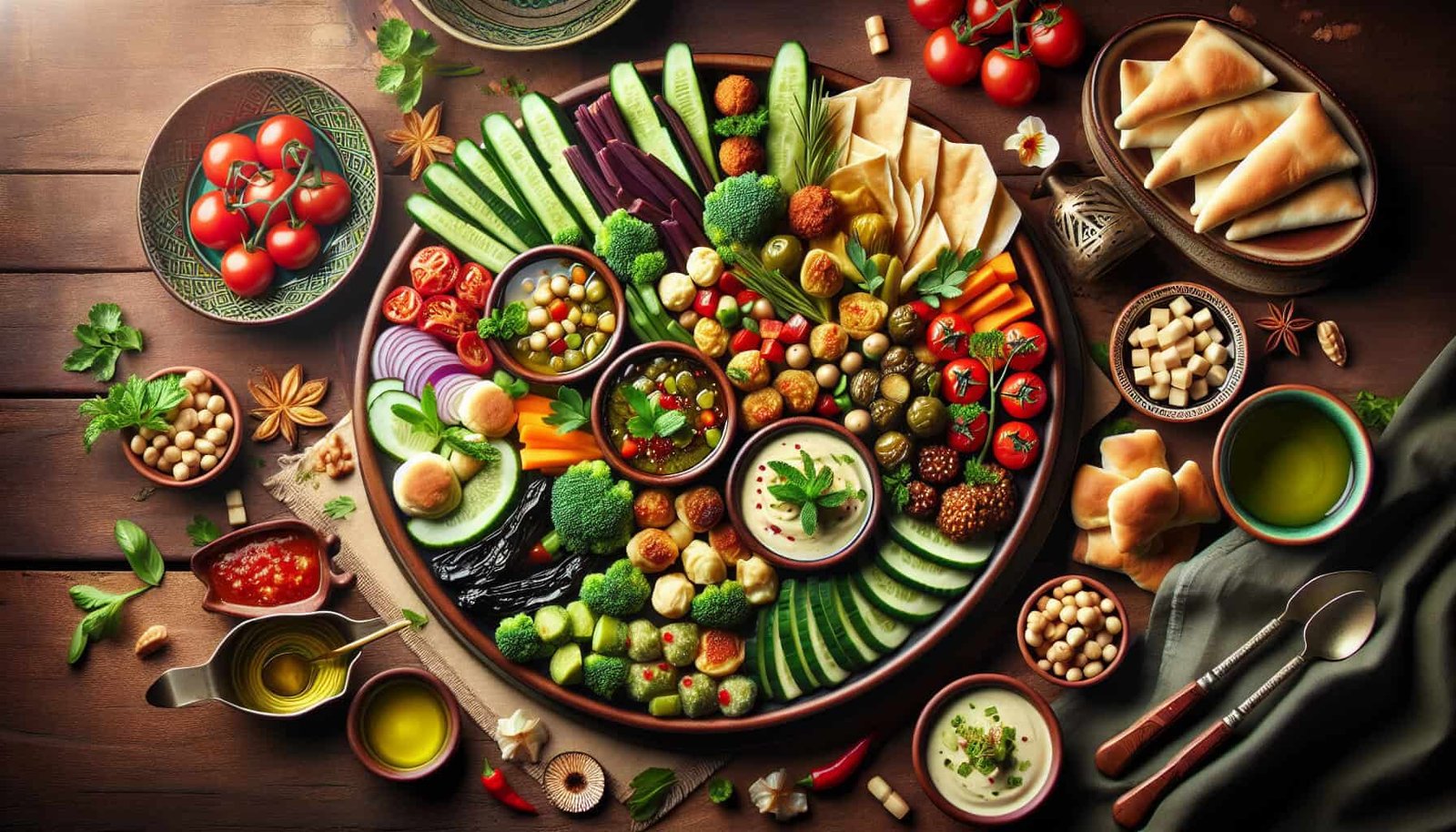Indulge in a culinary journey as you explore the vibrant flavors of the Middle East with a captivating mezze platter. Bursting with an array of vegetarian delights, this mouthwatering platter is perfect for sharing, bringing people together in a joyous celebration of food. From silky smooth hummus to tangy tabbouleh and crispy falafel, each bite transports you to the bustling streets of Beirut or the charming markets of Istanbul. So gather your friends and ignite your taste buds with this irresistible blend of flavors, colors, and textures. Get ready to embark on a delicious adventure that will leave you craving for more.

Introduction to Middle Eastern Mezze Platter
Middle Eastern cuisine is known for its vibrant flavors and rich variety of dishes, and one popular way to experience this culinary tradition is through a mezze platter. Mezze refers to a selection of small dishes that are served as appetizers or part of a shared meal. In Middle Eastern culture, sharing food is a way to foster a sense of community and togetherness. The mezze platter embodies this spirit of hospitality and is a great way to introduce your friends and family to the delicious world of Middle Eastern cuisine.
Definition of Mezze
Mezze is a term that encompasses a wide range of small, flavorful dishes. It typically includes a variety of vegetarian and non-vegetarian options, allowing everyone to find something they enjoy. Mezze dishes can vary from region to region, but they often include dips, salads, stuffed vegetables, and grilled or fried items. The emphasis is on fresh ingredients, bold spices, and complex flavors. Mezze is meant to be shared and enjoyed over a leisurely meal, often accompanied by drinks and good company.
Cultural Significance
The mezze platter holds great cultural significance in Middle Eastern cuisine. It reflects the values of hospitality, generosity, and community that are deeply ingrained in the region’s culture. Offering a mezze platter to your guests is a way of welcoming them into your home and sharing a piece of your culture with them. The act of sharing food also promotes conversation and connection, as people gather around the table to enjoy the diverse flavors and discuss the dishes. By serving a mezze platter, you are not only sharing delicious food but also creating a memorable dining experience.
Shared Dining Experience
One of the key elements of a mezze platter is the shared dining experience it offers. Mezze is typically served with a variety of dips, spreads, and salads, along with fresh bread or pita chips for dipping. As you and your guests gather around the table, you can take turns dipping into the different dishes, trying new flavors, and exchanging opinions. The communal nature of the mezze platter encourages a sense of camaraderie and creates an atmosphere of conviviality. It is a meal meant to be enjoyed at a leisurely pace, savoring each bite and engaging in lively conversation.

Popular Vegetarian Delights in Middle Eastern Cuisine
Middle Eastern cuisine offers a wide array of vegetarian delights that are perfect for a mezze platter. These dishes are not only packed with flavors but also showcase the region’s love for fresh produce and vibrant herbs. Here are some of the most popular vegetarian mezze options:
Hummus
Hummus is arguably the most famous Middle Eastern dip, made from chickpeas, tahini, garlic, lemon juice, and olive oil. It is smooth, creamy, and wonderfully tangy, making it an irresistible addition to any mezze platter. Serve it with warm pita bread or fresh vegetables for a satisfying and nutritious snack.
Baba Ganoush
Baba Ganoush is a smoky and flavorful dip made from roasted eggplant, tahini, garlic, lemon juice, and olive oil. The eggplant is charred over an open flame, giving the dip a distinct smoky flavor. It is perfect for spreading on warm bread or as a dip for crunchy vegetables.
Tabbouleh
Tabbouleh is a refreshing and vibrant salad made with bulgur wheat, parsley, mint, tomatoes, onions, lemon juice, and olive oil. It is light, zesty, and bursting with flavors. Tabbouleh adds a fresh and healthy element to your mezze platter and is a perfect accompaniment to other dishes.
Falafel
Falafel is a beloved Middle Eastern street food made from ground chickpeas or fava beans, mixed with herbs, spices, and onions, then deep-fried until crispy. These flavorful and protein-packed balls are usually served with tahini sauce or wrapped in warm pita bread with fresh veggies. Adding falafel to your mezze platter will surely be a crowd-pleaser.
Fattoush Salad
Fattoush is a colorful and tangy salad made with lettuce, tomatoes, cucumbers, radishes, mint, parsley, pita chips, and a zesty sumac dressing. It offers a delightful combination of textures and flavors, with the crunchy pita chips adding a satisfying crunch. Fattoush salad is an excellent addition to a mezze platter, as it adds freshness and vibrancy to the spread.
Creative Variations of Traditional Mezze Recipes
While traditional mezze dishes are delicious on their own, you can also get creative and put a unique twist on some of these classic recipes. By adding unexpected ingredients or experimenting with different flavor combinations, you can create exciting variations of traditional mezze recipes. Here are a few ideas to inspire you:
Roasted Red Pepper Hummus
Take the classic hummus recipe and add roasted red peppers for a smoky and slightly sweet twist. The roasted red peppers add depth of flavor and a vibrant color to the dip. Serve it with warm pita bread or as a spread for sandwiches and wraps.
Eggplant and Pomegranate Baba Ganoush
Elevate the traditional baba ganoush by incorporating tangy pomegranate molasses. The molasses adds a sweet and tangy flavor that complements the smoky eggplant perfectly. Top it off with pomegranate seeds for an extra burst of freshness and visual appeal.
Quinoa Tabbouleh
Swap out the bulgur wheat in the tabbouleh recipe for protein-rich quinoa. Quinoa adds a nutty flavor, a light texture, and an extra dose of nutrition to the salad. It is a great option for those looking for a gluten-free alternative or simply wanting to switch things up.
Spinach and Feta Stuffed Falafel
Give falafel a cheesy twist by stuffing them with a mixture of cooked spinach and crumbled feta cheese. The combination of savory spinach and creamy feta adds a delicious surprise when you bite into the crispy falafel. Serve them with tzatziki sauce for a refreshing and tangy accompaniment.
Watermelon and Mint Fattoush Salad
Incorporate the sweetness of watermelon into the traditional fattoush salad for a refreshing and summery twist. The juicy watermelon complements the tangy sumac dressing and the fresh herbs perfectly. This variation is a delightful way to add a touch of sweetness to your mezze platter.
By experimenting with different flavors and ingredients, you can create a mezze platter that is uniquely yours. Feel free to let your creativity shine and customize the recipes based on your preferences and the ingredients available to you.

Preparing the Mezze Platter
Creating a stunning mezze platter involves careful selection of ingredients and thoughtful arrangement. Here are some tips to help you prepare an impressive mezze platter:
Choosing a Variety of Vegetables
The mezze platter is a great opportunity to showcase a variety of fresh vegetables. Choose a mix of colors, textures, and flavors to create an appealing selection. Some great options include cherry tomatoes, cucumbers, radishes, bell peppers, and carrots. Cut them into bite-sized pieces, sticks, or slices for easy dipping.
Sourcing Quality Olives and Olive Oil
Olives are a staple in Middle Eastern cuisine, and they add a robust and briny element to your mezze platter. Look for high-quality olives such as Kalamata or green olives stuffed with pimento or garlic. Similarly, use extra-virgin olive oil to drizzle over salads or to dip bread into. The quality of the olives and olive oil can greatly enhance the flavors of your mezze dishes.
Selecting Fresh Herbs
Fresh herbs are a key component of Middle Eastern cuisine and can elevate the flavors of your dishes. Include a variety of herbs such as mint, parsley, cilantro, and dill to add freshness and aroma to your mezze platter. Garnish your dishes generously with herbs to enhance their visual appeal and flavor.
Incorporating Dips and Spreads
Dips and spreads are the stars of a mezze platter, providing a burst of flavor and a creamy element. Besides the classic hummus and baba ganoush, you can include other favorites like tzatziki, muhammara (a spicy red pepper dip), or labneh (a tangy yogurt cheese). Arrange them in small bowls or on platters, and encourage your guests to dip and mix flavors to their liking.
Adding Crunch with Pita Bread or Chips
No mezze platter is complete without something to scoop up all those delicious dips and spreads. Opt for warm, freshly-baked pita bread or toasted pita chips for a satisfying crunch. You can also include crispy lavash or other Middle Eastern flatbreads for variety. Cut the bread into triangles or tear it into pieces to make it easy to grab and dip.
By taking the time to curate a well-balanced selection of ingredients and paying attention to details, you can create a mezze platter that is visually appealing and bursting with flavors. Keep in mind that presentation plays a key role in the overall enjoyment of the meal, so take pride in arranging your mezze platter with care.
Accompaniments and Condiments
To elevate your mezze platter even further, consider adding a variety of accompaniments and condiments that complement the flavors of the dishes. These small additions can make a big difference in taste and presentation. Here are some ideas to enhance your mezze experience:
Yogurt Sauce with Garlic and Lemon
A tangy and zesty yogurt sauce is a versatile condiment that goes well with many mezze dishes. It provides a cooling element to counterbalance the spices and adds a creamy texture to the platter. Make a simple yogurt sauce by combining Greek yogurt, minced garlic, lemon juice, and a pinch of salt.
Tahini Sauce
Tahini sauce is made from sesame paste, lemon juice, garlic, and salt. It has a nutty and slightly bitter flavor that complements the richness of the mezze dishes. Use tahini sauce as a drizzle over grilled vegetables or as a dip for falafel and bread.
Marinated Feta Cheese
Marinated feta cheese adds a tangy and salty element to the mezze platter. You can marinate feta cheese in olive oil with herbs such as oregano, thyme, and rosemary, along with some crushed red pepper flakes for a bit of heat. Serve the marinated feta on its own or alongside other dishes.
Pickled Turnips
Pickled turnips are a staple in Middle Eastern cuisine and provide a crunchy and tangy element to the mezze platter. They are typically bright pink in color and have a refreshing flavor. You can easily make pickled turnips at home using turnips, vinegar, salt, and beetroot for the vibrant color.
Sumac Spice
Sumac is a bright red spice with a tangy and citrusy flavor. It is often sprinkled over salads, dips, or grilled meats to add a zesty kick. Sprinkle sumac over your hummus, baba ganoush, or fattoush salad for an extra burst of flavor and a pop of color.
Adding these accompaniments and condiments to your mezze platter will enhance the flavors, textures, and overall experience. Encourage your guests to experiment with different combinations and to explore the unique flavors that each accompaniment brings.

Presentation and Garnish
A well-presented mezze platter not only looks appetizing but also showcases the diversity of flavors and textures. Here are some tips to help you create a visually appealing and inviting mezze platter:
Arranging the Platter with Color and Texture
The key to an eye-catching mezze platter is to arrange the dishes with consideration for color and texture. Start by placing the larger dishes, such as the dips and salads, at the center of the platter. Surround them with smaller dishes of olives, vegetables, and accompaniments. Create contrast by arranging contrasting colors and textures side by side. For example, place the vibrant red roasted red pepper hummus next to the creamy white baba ganoush. This will make the platter visually appealing and inviting to your guests.
Garnishing with Fresh Herbs
Fresh herbs not only add flavor but also act as a garnish that enhances the visual appeal of your mezze platter. Sprinkle chopped herbs over the dips, salads, and vegetables to add a burst of freshness and a pop of color. Top baba ganoush with a few whole mint leaves or garnish hummus with a sprinkle of paprika or sumac for an extra touch of elegance.
Using Vibrant Fruits and Vegetables
Incorporating vibrant fruits and vegetables into your mezze platter can elevate the visual appeal. Add slices of lemon, lime, or orange for a burst of citrus color. Include pomegranate seeds or wedges for their vibrant red hues. Edible flowers like nasturtiums or pansies can also add a touch of whimsy and elegance to your platter.
Enhancing Visual Appeal with Edible Flowers
For an extra touch of beauty, consider using edible flowers as a garnish for your mezze platter. Edible flowers such as nasturtiums, pansies, or borage can provide a pop of color and a unique visual element. Make sure to use flowers that are safe for consumption and have not been treated with any chemicals. Simply place them on top of the dishes or delicately scatter them across the platter for an elegant and whimsical touch.
By paying attention to the presentation and garnish of your mezze platter, you can turn a simple assortment of dishes into an attractive and inviting spread. Take the time to arrange the dishes with care and use colorful ingredients and garnishes to create a mezze platter that is as visually appealing as it is delicious.
Pairing Mezze Platter with Middle Eastern Beverages
To complete the Middle Eastern dining experience, it is essential to pair your mezze platter with the right beverages. The region offers a wide variety of refreshing and flavorful drinks that complement the flavors of the mezze dishes. Here are some popular Middle Eastern beverages to consider:
Mint Lemonade
Mint lemonade is a refreshing and cooling drink that pairs perfectly with the bold flavors of the mezze platter. It is made by combining fresh lemon juice, sugar, water, and plenty of fresh mint leaves. Serve it chilled over ice, and garnish with a sprig of mint and a lemon slice.
Tamarind Juice
Tamarind juice is a sweet and tangy beverage commonly consumed in the Middle East. It is made by boiling tamarind pulp with water and adding sugar or honey to taste. The resulting drink is slightly sour, refreshing, and full of complex flavors. Serve it chilled or over ice for a thirst-quenching experience.
Turkish Tea
Turkish tea is a staple in Middle Eastern culture. It is a strong black tea that is typically served in small glasses with sugar cubes on the side. The strong flavor and warmth of the tea provide a great contrast to the bold and spicy flavors of the mezze dishes. Brew the tea using loose tea leaves or tea bags and serve it hot.
Arabic Coffee
Arabic coffee, also known as qahwa, is a traditional beverage that is usually served in small cups. It is made from lightly roasted coffee beans, cardamom, and sometimes other spices like saffron or cloves. Arabic coffee has a rich and aromatic flavor and is often enjoyed with dates or other sweet snacks. Serve it in small cups and enjoy its warm and comforting flavors.
Pomegranate Mocktail
For a non-alcoholic option, consider a refreshing and vibrant pomegranate mocktail. Mix pomegranate juice with sparkling water, a squeeze of lemon juice, and a dash of simple syrup or honey. Serve it over ice, garnished with a few pomegranate seeds for an elegant and flavorful drink.
By pairing your mezze platter with Middle Eastern beverages, you can enhance the flavors of the dishes and create a truly immersive dining experience. The refreshing and unique flavors of these drinks will complement the mezze platter and offer your guests a taste of Middle Eastern hospitality.

Tips for Hosting a Mezze Party
If you’re planning to host a mezze party, here are some tips to help you create a memorable and enjoyable experience for your guests:
Preparing in Advance
Mezze dishes are often best when made in advance, allowing flavors to meld and develop over time. Many dips and spreads actually taste better after a day or two in the refrigerator. Plan your menu and make a checklist of the dishes you want to prepare. Prepare as much as possible in advance, leaving only the final assembly and garnishing for closer to serving time.
Offering Vegetarian and Non-Vegetarian Options
Ensure your mezze platter caters to all dietary preferences by offering a balance of vegetarian and non-vegetarian options. This will allow your guests to choose what suits their taste and dietary needs. Include a variety of vegetarian delights as discussed earlier, alongside options like grilled chicken skewers or lamb kebabs for those who enjoy meat.
Creating a Welcoming Atmosphere
Set the tone for a warm and inviting gathering by creating a welcoming atmosphere. Decorate the space with Middle Eastern-inspired elements such as vibrant fabrics, candle lanterns, and colorful tableware. Play soft Middle Eastern music in the background to enhance the ambiance. Encourage your guests to embrace the spirit of sharing and to indulge in the diverse flavors of the mezze platter.
Encouraging Sharing and Conversations
Mezze is all about sharing and enjoying each other’s company. Encourage your guests to take part in the shared dining experience by passing around dishes, sharing their thoughts on flavors, and engaging in conversations about the food. Providing small plates, napkins, and extra utensils can make it easier for guests to serve themselves and share their favorite bites.
By following these tips, you can ensure that your mezze party is a delightful and memorable experience for your guests. Embrace the spirit of Middle Eastern hospitality by creating a warm and inviting atmosphere that encourages sharing, conversation, and the joy of discovering new flavors.
Expanding the Mezze Platter Experience
While vegetarian delights are a fantastic addition to any mezze platter, you can further expand its range of flavors by incorporating non-vegetarian mezze dishes. Here are some popular non-vegetarian options to consider:
Grilled Lamb Kofta
Grilled lamb kofta is a flavorful and juicy addition to a mezze platter. These spiced ground lamb skewers are typically seasoned with aromatics such as garlic, onions, cumin, and coriander. Serve them alongside the vegetarian dishes to provide a satisfying and savory option for meat lovers.
Chicken Shawarma
Chicken shawarma is a beloved Middle Eastern street food. It consists of marinated and seasoned grilled chicken that is thinly sliced and usually served in pita bread with a variety of toppings and sauces. Offer sliced chicken shawarma as a filling option for those who prefer a non-vegetarian option.
Stuffed Grape Leaves
Stuffed grape leaves, also known as dolma or dolmades, are a classic Middle Eastern appetizer. They are made by wrapping grape leaves around a flavorful mixture of rice, herbs, and sometimes ground lamb or beef. These bite-sized delights are perfect for adding variety and texture to your mezze platter.
Including these non-vegetarian mezze options alongside the vegetarian dishes will provide a diverse range of flavors and cater to different dietary preferences. The combination of vegetarian and non-vegetarian options ensures that there is something for everyone to enjoy.
Exploring Lesser-Known Middle Eastern Delights
In addition to the popular mezze dishes discussed earlier, Middle Eastern cuisine offers a wealth of lesser-known delights that can elevate your mezze platter even further. Exploring these lesser-known dishes will not only introduce your guests to new flavors but also showcase the depth and diversity of Middle Eastern cuisine. Here are a few examples to consider:
Muhammara
Muhammara is a spicy and flavorful dip made from roasted red peppers, walnuts, breadcrumbs, pomegranate molasses, and spices such as cumin and chili flakes. It has a complex and slightly sweet taste that pairs beautifully with grilled meats or as a spread on a slice of warm bread.
Moutabal
Moutabal is a creamy and smoky eggplant dip similar to baba ganoush. It is made by grilling or roasting eggplants until they are tender and charred, then blending them with tahini, lemon juice, garlic, and olive oil. The smoky flavor of moutabal is bold and distinct, making it a delightful addition to a mezze platter.
Kibbeh
Kibbeh is a popular dish found in various Middle Eastern countries. It consists of a mixture of ground meat (typically lamb or beef), bulgur wheat, onions, and spices, which is shaped into balls or patties and either fried or baked. The outer shell is crispy, while the filling is savory and aromatic. Serve kibbeh alongside other mezze dishes for a fantastic combination of textures and flavors.
Labneh with Za’atar
Labneh is a tangy and creamy yogurt cheese that is well-suited for mezze platters. It can be easily made at home by straining plain yogurt until it thickens to a cheese-like consistency. Serve labneh drizzled with olive oil and sprinkled with za’atar, a fragrant blend of dried herbs, sesame seeds, and sumac. This combination is a delightful addition to the flavors of the mezze platter.
By exploring these lesser-known delights of Middle Eastern cuisine, you can further expand your culinary horizons and offer your guests a mezze experience that goes beyond the classics. Embrace the excitement of discovering new flavors and encourage your guests to do the same.
Conclusion
A Middle Eastern mezze platter is a celebration of the richness and diversity of Middle Eastern cuisine. By focusing on vegetarian delights, you can create a platter that is both delicious and inclusive. From the creamy hummus to the smoky baba ganoush, the vibrant tabbouleh, and the crispy falafel, each dish tells a story and offers a unique flavor profile. By incorporating creative variations of traditional recipes and carefully arranging the platter with vibrant colors and textures, you can create a visually stunning spread that will impress your guests.
The mezze platter experience goes beyond the dishes themselves. It encompasses the cultural significance of sharing a meal, the warm and welcoming atmosphere, and the joy of discovering new flavors. By hosting a mezze party, you are inviting your guests into a vibrant culinary journey through the Middle East, nourishing not only their bodies but their spirits as well.
So, gather your loved ones, set the table, and prepare to embark on a mezze adventure that will create unforgettable memories. Celebrate the richness of Middle Eastern cuisine, embrace the vegetarian delights it has to offer, and create a dining experience that will leave a lasting impression.
